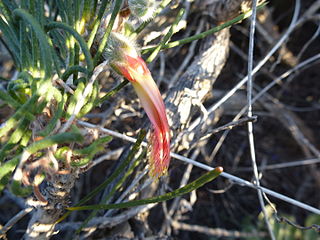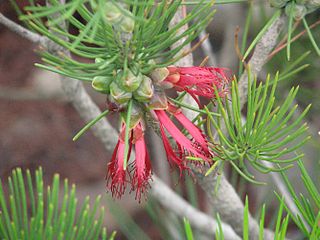
Calothamnus is a genus of shrubs in the family Myrtaceae and is endemic to the south-west of Western Australia. The common names one-sided bottlebrush or claw flower are given to some species due to their having the flowers clustered on one side of the stem or because of the claw-like appearance of their flowers. Calothamnus species are generally medium to tall woody shrubs with crowded leaves. In most species the leaves are crowded and linear in shape, and the flowers are usually arranged in dense clusters. The petals are small and fall off the flower soon after it opens but the stamens are long, numerous and usually bright red.

Calothamnus quadrifidus, commonly known as one-sided bottlebrush, is a plant in the myrtle family, Myrtaceae and is endemic to the south-west of Western Australia. The common name alludes to the arrangement of the flowers in the inflorescence which line up on one side of the stem. It is a shrub with grey-green, pine-like foliage covered with soft hairs and red, four-part flowers in spring. Widely cultivated because of its attractive foliage, colourful, unusual and prolific flowers, it grows in a variety of habitats and soils. In 2010, Alex George published a review of the species based on recent research and described a number of new subspecies.

Calothamnus chrysanthereus , commonly known as claw flower is a plant in the myrtle family, Myrtaceae and is endemic to the south-west of Western Australia. It is an erect shrub with needle-shaped leaves crowded on the ends of the branches and bright red flowers in spring.

Calothamnus sanguineus, commonly known as silky-leaved blood flower, is a plant in the myrtle family, Myrtaceae and is endemic to the south-west of Western Australia. The Noongar peoples know the plant as Boolgalla. It is an erect to spreading shrub with short, cylindrical leaves and red or white flowers with an unusual arrangement of stamens, often flowering in autumn, winter or spring. It was the first of its genus to be formally described.

Calothamnus graniticus, commonly known as granite claw flower, is a plant in the myrtle family, Myrtaceae and is endemic to the south-west of Western Australia. There are two subspecies, both of which have been classified as "near threatened". It is an erect, rounded shrub with pine-like, dark, grey-green foliage and usually bright red flowers. Calothamnus graniticus subsp. graniticus occurs in the Leeuwin-Naturaliste National Park and is the floral emblem of the nearby city of Busselton.
Calothamnus accedens, commonly known as Piawaning clawflower, is a plant in the myrtle family, Myrtaceae and is endemic to the south-west of Western Australia. It was first formally described in 1984, declared extinct in 1992, rediscovered in 2004, removed from the "extinct" list in 2013 and found to have a population of at least 25,000 in 2015. It is a small erect shrub with crowded hairy leaves and red flowers. In 2014 Craven, Edwards and Cowley proposed that the species be renamed Melaleuca accedens.

Calothamnus brevifolius is a plant in the myrtle family, Myrtaceae and is endemic to the south-west of Western Australia. It is a small, highly branched shrub with almost cylindrical, pointed leaves and red flowers in summer. In 2014 Craven, Edwards and Cowley proposed that the species be renamed Melaleuca hawkeswoodii.

Calothamnus aridus is a plant in the myrtle family, Myrtaceae and is endemic to central parts of Western Australia. It is an erect, densely branched shrub with many stems, needle-like leaves and orange-red to pinkish flowers, growing in arid areas with spinifex.
Calothamnus borealis is a plant in the myrtle family, Myrtaceae and is endemic to the south-west of Western Australia. It is a small, erect shrub with crowded, cylindrical leaves and red flowers. It grows in sand surrounded by spinifex or heath. In 2014 Craven, Edwards and Cowley proposed that the species be renamed Melaleuca aquilonia.
Calothamnus arcuatus is a plant in the myrtle family, Myrtaceae and is endemic to the south-west of Western Australia. It is a shrub with prickly, cylindrical leaves with a slight, upward curve and bright red flowers in small groups near the older leaves.
Calothamnus cupularis is a plant in the myrtle family, Myrtaceae and is endemic to the south-west of Western Australia. It is a similar shrub to Calothamnus formosus but has larger flowers and fruit.
Calothamnus glaber is a plant in the myrtle family, Myrtaceae and is endemic to near-coastal areas in the south-west of Western Australia. It is a shrub, similar to Calothamnus blepharospermus but its leaves are slightly longer and narrower and the parts of its flowers are glabrous.

Calothamnus hirsutus is a plant in the myrtle family, Myrtaceae and is endemic to the south-west of Western Australia. It is a small, spreading shrub with prominent hairs on the leaves giving them a smoky appearance. The flowers are deep red and are usually in dense clusters between the older leaves.
Calothamnus lehmannii, commonly known as dwarf claw flower, is a plant in the myrtle family, Myrtaceae and is endemic to the south-west of Western Australia. It is a low-lying, sometimes ground-hugging shrub with long, thin, cylindrical leaves and clusters of red flowers that are smaller than any others in the genus Calothamnus.
Calothamnus macrocarpus is a plant in the myrtle family, Myrtaceae and is endemic to the south-west of Western Australia. It is an erect shrub with bright red flowers in spring and large, almost spherical fruit. It has a limited distribution near Hopetoun.
Calothamnus phellosus is a plant in the myrtle family, Myrtaceae and is endemic to the south-west of Western Australia. It is a tall, spreading shrub with needle-shaped, prickly leaves and bright red flowers with five stamen bundles.
Calothamnus quadrifidus subsp. obtusus is a plant in the myrtle family, Myrtaceae and is endemic to the south-west of Western Australia. It is similar to other subspecies of Calothamnus quadrifidus except that its leaves are linear and somewhat rough and scaly and the stamen bundles are relatively short.
Calothamnus scabridus is a plant in the myrtle family, Myrtaceae and is endemic to the south-west of Western Australia. It is a shrub with needle-shaped, prickly leaves and red flowers with four stamen bundles.
Calothamnus superbus is a plant in the myrtle family, Myrtaceae and is endemic to the south-west of Western Australia. It is an erect, often spreading, straggly shrub similar to Calothamnus aridus with its red flowers having 5 stamen bundles, but its leaves are longer and wider. It has a limited distribution near Pigeon Rocks south of Lake Barlee.

Calothamnus tuberosus is a plant in the myrtle family, Myrtaceae and is endemic to the south-west of Western Australia. It is a stiff, prickly plant with cylindrical leaves and red flowers, growing near or often on granite boulders. It has a lignotuber and tuberous roots.







